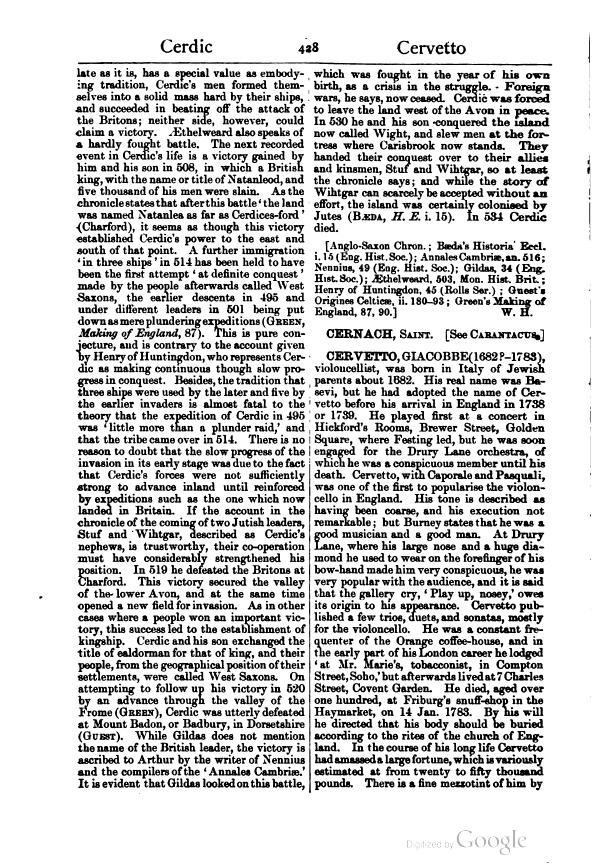late as it is, has a special value as embodying tradition, Cerdic's men formed themselves into a solid mass hard by their ships, and succeeded in beating off the attack of the Britons; neither side, however, could claim a victory. Æthelweard also speaks of a hardly fought battle. The next recorded event in Cerdic's life is a victory gained by him and his son in 508, in which a British king, with the name or title of Natanleod, and five thousand of his men were slain. As the chronicle states that after this battle 'the land was named Natanlea as far as Cerdices-ford' (Charford), it seems as though this victory established Cerdic's power to the east and south of that point. A further immigration 'in three ships' in 514 has been held to have been the first attempt 'at definite conquest' made by the people afterwards called West Saxons, the earlier descents in 495 and under different leaders in 501 being put down as mere plundering expeditions (Green, Making of England, 87). This is pure conjecture, and is contrary to the account given by Henry of Huntingdon, who represents Cerdic as making continuous though slow progress in conquest. Besides, the tradition that three ships were used by the later and five by the earlier invaders is almost fatal to the theory that the expedition of Cerdic in 495 was 'little more than a plunder raid,' and that the tribe came over in 514. There is no reason to doubt that the slow progress of the invasion in its early stage was due to the fact that Cerdic's forces were not sufficiently strong to advance inland until reinforced by expeditions such as the one which now landed in Britain. If the account in the chronicle of the coming of two Jutish leaders, Stuf and Wihtgar, described as Cerdic's nephews, is trustworthy, their co-operation must have considerably strengthened his position. In 519 he defeated the Britons at Charford. This victory secured the valley of the lower Avon, and at the same time opened a new field for invasion. As in other cases where a people won an important victory, this success led to the establishment of kingship. Cerdic and his son exchanged the title of ealdorman for that of king, and their people, from the geographical position of their settlements, were called West Saxons. On attempting to follow up his victory in 520 by an advance through the valley of the Frome (Green), Cerdic was utterly defeated at Mount Badon, or Badbury, in Dorsetshire (Guest). While Gildas does not mention the name of the British leader, the victory is ascribed to Arthur by the writer of Nennius and the compilers of the 'Annales Cambriæ.' It is evident that Gildas looked on this battle, which was fought in the year of his own birth, as a crisis in the struggle. Foreign wars, he says, now ceased. Cerdic was forced to leave the land west of the Avon in peace. In 530 he and his son conquered the island now called Wight, and slew men at the fortress where Carisbrook now stands. They handed their conquest over to their allies and kinsmen, Stuf and Wihtgar, so at least the chronicle says; and while the story of Wihtgar can scarcely be accepted without an effort, the island was certainly colonised by Jutes (Bæda, H. E. i. 15). In 534 Cerdic died.
[Anglo-Saxon Chron.; Bæda's Historia Eccl. i. 15 (Eng. Hist. Soc.); Annales Cambriæ, an. 516; Nennius, 49 (Eng. Hist. Soc.); Gildas, 34 (Eng. Hist. Soc.); Æthelweard, 503. Mon. Hist. Brit.; Henry of Huntingdon, 45 (Rolls Ser.); Guest's Origines Celticæ. ii. 180-93; Green's Making of England, 87, 90.]
CERNACH, Saint. [See Carantacus.]
CERVETTO, GIACOBBE (1682?–1783), violoncellist, was born in Italy of Jewish parents about 1682. His real name was Basevi, but he had adopted the name of Cervetto before his arrival in England in 1738 or 1739. He played first at a concert in Hickford's Rooms, Brewer Street, Golden Square, where Festing led, but he was soon engaged for the Drury Lane orchestra, of which he was a conspicuous member until his death. Cervetto, with Caporale and Pasquali, was one of the first to popularise the violoncello in England. His tone is described as having been coarse, and his execution not remarkable; but Burney states that he was a good musician and a good man. At Drury Lane, where his large nose and a huge diamond he used to wear on the forefinger of his bow-hand made him very conspicuous, he was very popular with the audience, and it is said that the gallery cry, ‘Play up, nosey,’ owes its origin to his appearance. Cervetto published a few trios, duets, and sonatas, mostly for the violoncello. He was a constant frequenter of the Orange coffee-house, and in the early part of his London career he lodged ‘at Mr. Marie's, tobacconist, in Compton Street, Soho,’ but afterwards lived at 7 Charles Street, Covent Garden. He died, aged over one hundred, at Friburg's snuff-shop in the Haymarket, on 14 Jan. 1783. By his will he directed that his body should be buried according to the rites of the church of England. In the course of his long life Cervetto had amassed a large fortune, which is variously estimated at from twenty to fifty thousand pounds. There is a fine mezzotint of him by
